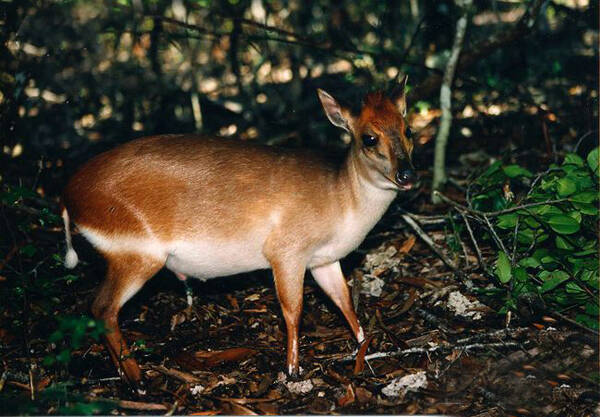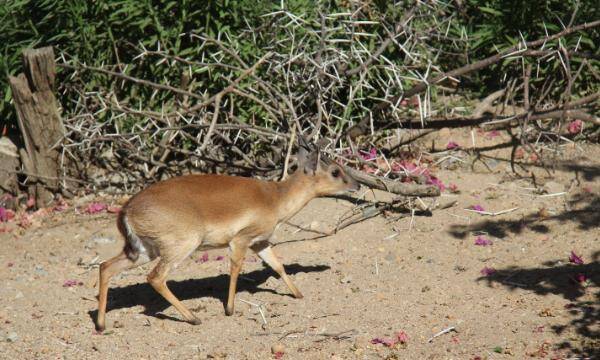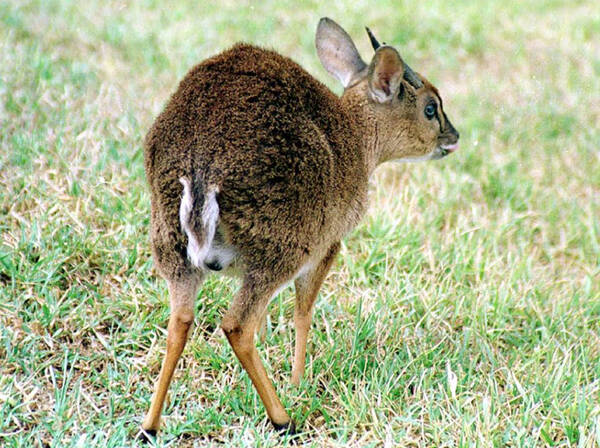Neotragus moschatus
IUCN
LCBasic Information
Scientific classification
- name:Neotragus moschatus
- Scientific Name:Neotragus moschatus
- Outline:Ungulata
- Family:Artiodactyla Bovidae Neosibirica
Vital signs
- length:57-62cm
- Weight:4-6kg
- lifetime:About 13 years
Feature
The overall color varies, and the ears are thin-skinned, large and round, and appear translucent pink in the sun.
Distribution and Habitat
Kenya, Malawi, Mozambique, South Africa, Tanzania and Zimbabwe.
Presence uncertain: Swaziland.
The Zangoensis was once widespread in forests and scrubland along the coast and hinterland from Kenya to KwaZulu-Natal, South Africa. In Kenya, it extends northwards to Mount Kenya and Aberdare National Parks, along the coast northwards to the Boni-Dodori Forest, and southwards to Lake St Lucia. Northeastern KwaZulu-Natal (about 28°S). They may also be present in Swaziland. Lives from Zanzibar and some neighboring islands (Mafia and Chapani, and introduced to Manbeba), but not Pemba. Introduced to Rubondo Island in Lake Victoria in the 1960s.
Inhabits coastal forests and scrubland, dry deciduous scrubland, montane forests below 2700 m, and other areas of dense scrubland. In some areas it may benefit from the expansion of secondary scrub habitats caused by human activities (e.g. in Zanzibar) and readily colonizes degraded forests, either in montane forests or coastal reed scrub, thick
Appearance
The Sandao New Duiker weighs 4-6 kg and is 57-62 cm long. It is a very small antelope with a slender body and relatively high hindquarters. It has a distinct crouching form and slender legs. The overall color varies from gray, chestnut, brown to brown, with spots on the back and whiter sides with a reddish tint. The chin, throat, underparts and inner sides of the legs are white. Each leg is ringed with a black band above the hoof. The tail is dark chestnut above, approaching black in some populations; the underside is white.
The ears are thin-skinned, large and round, and appear translucent pink in the sun. The head is broad and tapers to a narrow muzzle. Both sexes have long slit-like preorbital glands in front of their eyes. These are particularly noticeable in adult males. The eyes are lightly ringed, and only males have short, thorn-like horns with a wide base, black, ridged and tilted backwards, aligned with the face. The horns are 6.5-13 cm long and have very distinct ridges.
Details
Neotragus moschatus (scientific name: Neotragus moschatus): It is the only species of the genus Neotragus in the order Artiodactyla, family Bovidae, and is a very small antelope with 4 subspecies.

The Sangdao Neogaur and its many subspecies were from 1972 to 2005, belonging to the genus Neotragus, which originally included the Bess Island Gazelle and the Royal Island Gazelle, and also included the later independent genus Nesotragus. There are four subspecies in the genus Neotragus, but their morphological boundaries have not yet been clearly described. Here, only the species is assessed.
The kudu is territorial, with males defending territories of 0.5-3.6 ha; these males' territories may overlap with several females, but there are no strong social bonds between them. Males use glandular secretions to mark family territories of around 3 ha. The areas surrounding these territories may also have individual or communal dung piles. In good habitat, population densities may exceed 17 individuals per square kilometer.
The kudu is generally described as a shy animal, more active at dawn and dusk and at night. It sleeps in sheltered and shady places throughout the day. They frequently use paths that run through the range of each family's territory, and sleeping spots are often reused. The kudu is sensitive to predators and will often hide in dry grass and remain static. A high-pitched nasal whistle alarm call is emitted before fleeing. The fur color and facial appearance of the Sangodon provide considerable camouflage, which they use to their advantage by standing still and remaining hidden when responding to danger. Only when a potential predator is clearly a threat can they escape by quickly jumping out of sight.

Based on studies of gastric anatomy and digestive physiology, it is speculated that the Sandao New Duiker requires a diet high in energy, easily digestible, and low in fiber, such as fruits, flowers, and the tender tips of dicotyledonous plants. However, further studies have shown that the species' diet consists mainly of leaf litter, which is abundant in its habitat but has low nutritional quality. In the Zanzibar region, the saury share the same habitat as long-tailed monkeys and red colobus monkeys. It eats fallen leaves, buds, young shoots, fruits and fungi. It gets its moisture from vegetation and is therefore not dependent on water sources (Honolulu Zoo).
Adult male saury usually mates with 1-4 females. Females breed year-round, with regional birth rates peaking from September to December in South Africa and November to February in Tanzania. Gestation period is 6-7 months (recorded as 179-214 days), with one calf born per litter, and a lactation period of 3-4 months. The calves are initially hidden by the females in dense vegetation, and the mothers regularly nurse and feed them. They start eating solid food very early (as early as three days old) and grow rapidly. Females become sexually mature at about 1 year old. Lifespan is up to 13 years.
The total population of the Sanzio duiker is estimated at about 365,000 individuals, with numbers considered stable across most of its range. They live in protected areas, their adaptability to secondary vegetation, and their resilience to hunting should allow them to maintain satisfactory numbers across a significant portion of their current range for the foreseeable future. The species lives at relatively high population densities in common areas, for example, surveys have shown densities of 13-17 individuals per square kilometer in areas such as Zanzibar and Lengwe National Park, and lower densities in South Africa, at 0.9 individuals per square kilometer in Mkuzi Game Reserve. The total population was estimated at 365,000 in 1999. Population trends are likely to remain stable across most of its range, but have declined in protected areas where hunting pressure is very high, and in some areas where vervet monkeys and red-wart ironwoods are found, overpopulation and a corresponding decline in shrub density (2013).

The Sangokud is a very hardy species that can generally withstand moderately high hunting pressure, although overhunting has probably reduced numbers across much of its range in Kenya, and local overhunting has led to low densities in areas such as near villages. The species has been eliminated from much of its former range in South Africa, where it is now a rare species, due to expanded agricultural areas, as well as settlement and hunting by poachers and uncontrolled dogs. The survival of the new duiker is also threatened by the increase in the number of Tragelaphus angasii in some protected areas and private ranches and the reduction of bush cover.
Important protected areas occur in Aberdares N.P. and Mount Kenya National Park. Serengeti National Park, Tanzania; Lengwe National Park, Malawi; Maputo National Park, Mozambique; Tembe National Park, Congo (DRC); Mokuzi Game Reserve and Ngadum Game Reserve. In 1995, 39 captive-bred new duikers were released in an area of dense bushland northeast of Kruger National Park, which was believed to have suitable habitat, but by early 1998 there was no evidence of the success of this reintroduction (1999).
Listed in the IUCN Red List of Threatened Species in 2016 ver 3.1 - Least Concern (LC).
Protect wild animals and eliminate game.
Maintaining ecological balance is everyone's responsibility!








